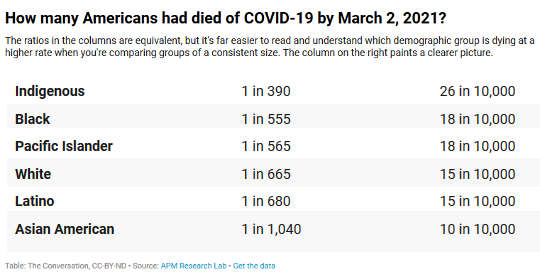
Understanding vaccine effectiveness stats can help you weigh the risks of travel. AP Photo/Rick Bowmer
The COVID-19 pandemic thrust many news consumers into a world of statistics and deep uncertainty. An endless swirl of numbers – case counts, infection rates, vaccine efficacy – can leave you feeling stressed, anxious and powerless if you’re not confident you know what they really mean.
But when used effectively, statistics can help you know more, trust more and avoid surprise and regret when the unexpected occurs. People also tend to want them and find them useful when weighing uncertain risks and making decisions.
I’m a decision psychologist. I study how people understand and use numbers as they’re figuring out risks and making choices. I then try to improve how numbers are communicated to help people make better decisions. Here are four ways that stats in the news can confuse you – and my advice on how to understand them.
1. Look for consistent categories
Uncertainty and risk are often presented numerically. Rain is 35% likely today; 10% of patients will suffer this side effect. But sometimes how those numbers are presented is confusing.
For example, early in the pandemic, The New York Times tweeted that “nearly half of New York City voters know someone who died of Covid-19. 74% of white voters said they did not know someone who died from coronavirus, but 48% of black voters, and 52% of Latino voters, said they did.”
Notice that some statistics referred to knowing someone, and others to not knowing someone.
This difference shouldn’t matter because once you know the proportion of people who knew someone who died, you also know the proportion who didn’t – people either know someone or they don’t. If 74% of white voters didn’t know someone, then 26% did know someone (74% plus 26% = 100%).
But how options are described can be misleading. In a classic example, researchers described cancer treatment options either in terms of survival (that is, 90% of patients survive) or mortality (10% died). The numbers are logically the same in both descriptions. But people, including experts, tend to feel worse when a likelihood is described in the negative mortality frame, and they’re less likely to choose a treatment described in those terms. People who are not great with numbers are even more likely to be swayed by the positive or negative frame.
When you’re reading a tweet like the one above, pay attention to the words as well as the numbers. Are they describing things in a consistent way? If not, consider the flip side. The tweet should have read “26% of white voters said they knew someone who died from the coronavirus, and so did 48% of black voters, and 52% of Latino voters.” With consistency between numbers and words, you can more easily compare across groups.
2. Convert numbers for easier comparison
Numbers can be communicated in other ways, too, that make them hard to decipher. One example comes from a list of the proportion of people in the U.S. who died of COVID-19 within several racial categories.

It’s challenging to make out which groups have fared worse during the pandemic when you’re looking at a “one in something” format.
That “something” is the denominator of the fraction. It’s far easier to understand the data if you pick a single number you want them all to be out of. This becomes the new denominator. I chose 10,000 because it was bigger than the other denominators.
Then, divide 10,000 by what the original number was “out of” (the original denominator). For example, with the category Indigenous Americans, I divided 10,000 by 390. That equals 25.6, or approximately 26. Therefore, I wrote 26 in 10,000 Indigenous Americans.
So instead of 1 in 390 versus 1 in 665, you can compare 26 in 10,000 versus 15 in 10,000. It’s a lot easier to see that Indigenous Americans died at almost twice the rate of white Americans.
3. Think about absolute vs. relative percentages
CNN recently wrote about flying safely, claiming that 90% vaccine effectiveness meant that “for every million fully vaccinated people who fly, some 100,000 could still become infected.”
This is grossly incorrect.
Vaccine effectiveness concerns the relative risk of getting infected if you get the vaccine compared with not getting it. To calculate it, you need two groups of people, one vaccinated, one not. You wait and see what infections emerge in both groups. Then you calculate the proportion of people in the vaccinated group who got infected and the proportion of people in the unvaccinated group who did.
Divide the vaccinated proportion by the unvaccinated proportion, and the resulting number is the risk ratio. One minus the risk ratio is vaccine effectiveness, the 90% number from a recent study published by the Centers for Disease Control and Prevention.
What this number means is that, all else being equal, with vaccination, you are 10 times less likely to get a COVID-19 infection. This is true whether you live in Michigan or Oregon, fly on planes or don’t, even wear a mask or don’t. Whatever the average infection rate you face – based on where you live and how you act – you are 10 times less likely to get infected if you get vaccinated.
 A vaccine with 90% effectiveness does not mean 10% of vaccinated travelers will get COVID-19. AP Photo/Sue Ogrocki
A vaccine with 90% effectiveness does not mean 10% of vaccinated travelers will get COVID-19. AP Photo/Sue Ogrocki
Next time you see a percentage number, stop and think about whether it’s an absolute number, like the percentage who know or don’t know someone who has died from COVID-19. Or is it a relative percentage, like vaccine effectiveness – a comparison of people who get vaccinated to those who do not.
A 90% effective vaccine means that, if in a group of 1 million unvaccinated people who flew, 100 of them got infected, then among 1 million vaccinated people who flew, only 10 of them would get COVID-19.
These vaccines are imperfect, but they are phenomenally effective in that relative sense.
4. Don’t let an anecdote displace the data
News articles often tell a story about an individual that draws readers in. You can be tricked by these compelling stories, though, especially if any accompanying numbers are hard to understand.
Leilani Jordan continued to work as a clerk at a Maryland grocery store so she could help seniors, even though she had cerebral palsy and came in frequent contact with the public. She ultimately died from COVID-19, but her story may have persuaded some people to behave more carefully.
Some celebrity stories may have had the opposite effect. Tom Hanks and Rita Wilson had particularly mild cases of COVID-19. Reading about them may have reduced worry and caused some people to ease off hand-washing and physical distancing.
When you read a story, think carefully about what’s useful. Stories can help you understand experiences – what it feels like to have COVID-19 or become unemployed because of the pandemic. But they leave out other experiences and don’t tell you how common different experiences are.
After being drawn into a good story, think about how relevant it is to you and what is its likelihood. You can even look up statistics to better inform yourself about a situation rather than rely on anecdotes that might leave you with a false impression.
Knowing statistics can help you, but sometimes you need to empower yourself to understand what the numbers are telling you.![]()
About The Author
Ellen Peters, Director, Center for Science Communication Research, University of Oregon

Related Books:
Atomic Habits: An Easy & Proven Way to Build Good Habits & Break Bad Ones
by James Clear
Atomic Habits provides practical advice for developing good habits and breaking bad ones, based on scientific research on behavior change.
Click for more info or to order
The Four Tendencies: The Indispensable Personality Profiles That Reveal How to Make Your Life Better (and Other People's Lives Better, Too)
by Gretchen Rubin
The Four Tendencies identifies four personality types and explains how understanding your own tendencies can help you improve your relationships, work habits, and overall happiness.
Click for more info or to order
Think Again: The Power of Knowing What You Don't Know
by Adam Grant
Think Again explores how people can change their minds and attitudes, and offers strategies for improving critical thinking and decision making.
Click for more info or to order
The Body Keeps the Score: Brain, Mind, and Body in the Healing of Trauma
by Bessel van der Kolk
The Body Keeps the Score discusses the connection between trauma and physical health, and offers insights into how trauma can be treated and healed.
Click for more info or to order
The Psychology of Money: Timeless lessons on wealth, greed, and happiness
by Morgan Housel
The Psychology of Money examines the ways in which our attitudes and behaviors around money can shape our financial success and overall well-being.
Click for more info or to order
This article is republished from The Conversation under a Creative Commons license. Read the original article.






















